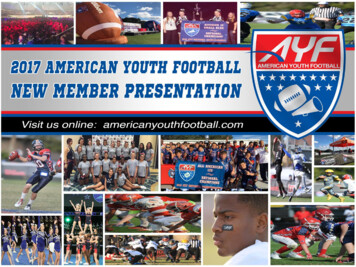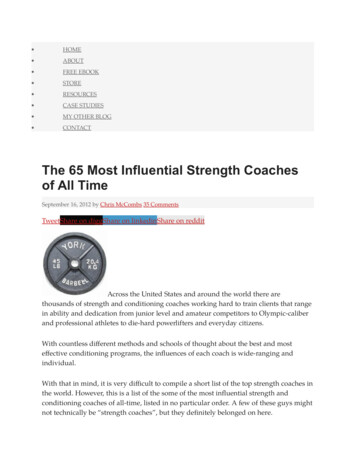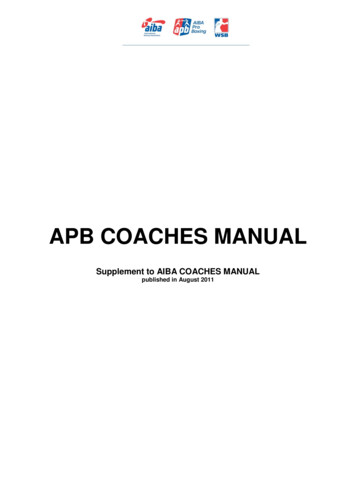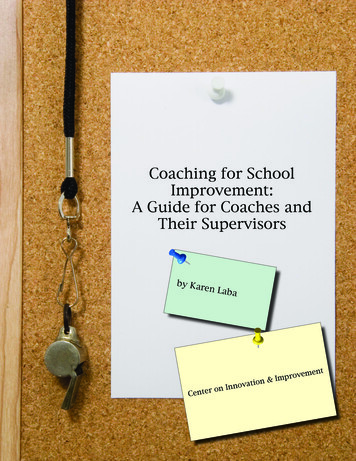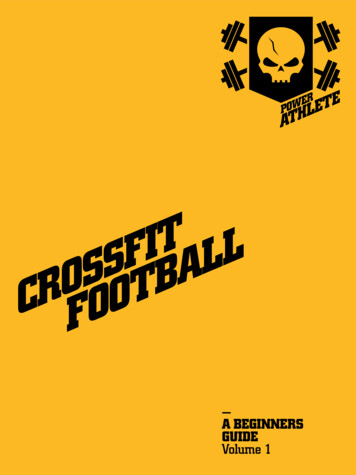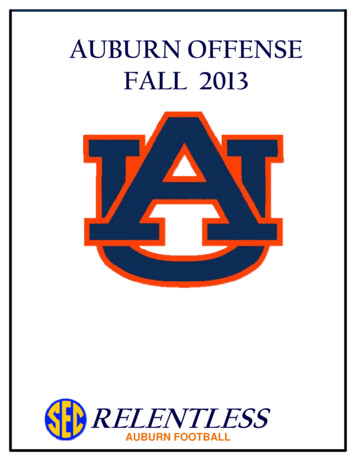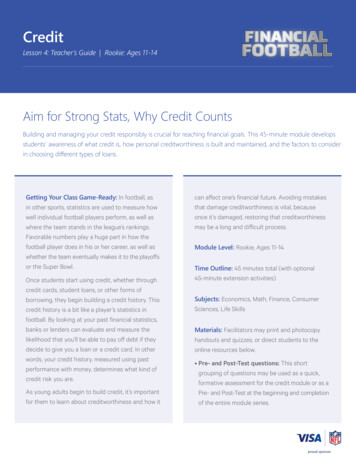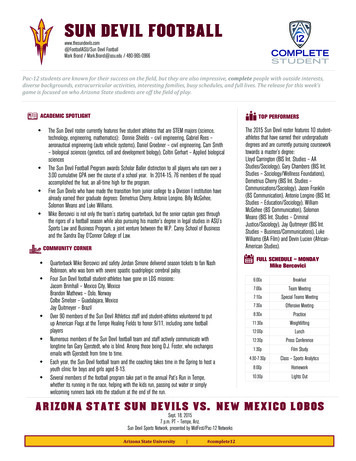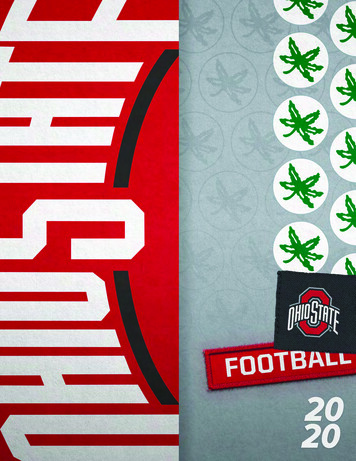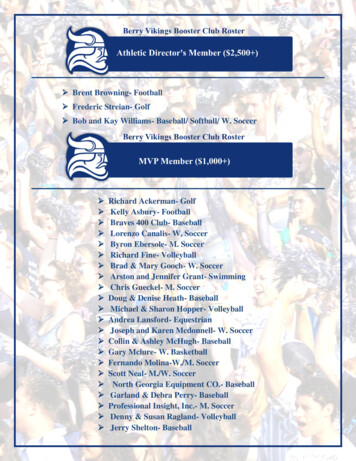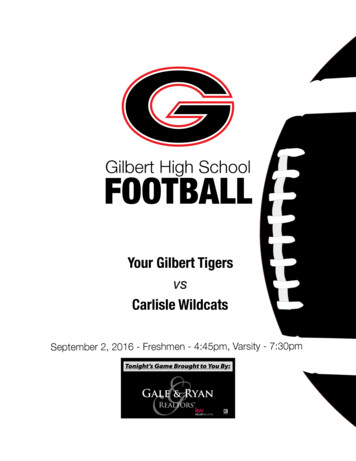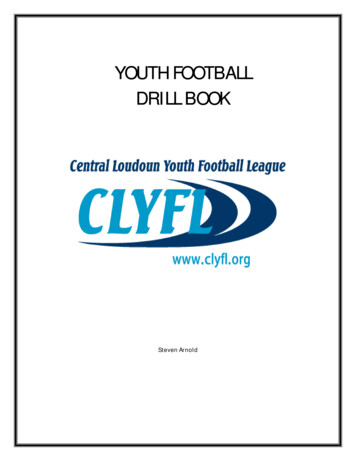
Transcription
YOUTH FOOTBALLDRILL BOOKSteven Arnold
CONTENTSSection 1: GAMES & WARM-UPS1.2.3.4.5.6.7.8.9.10.11.12.Drop Back Passing LinesSprint Out Passing LinesDynamic Warm-upRed Line / Gold LineTowel GameDeer HunterSumo DrillKing of the HillGladiator BallGolf FootballSlam DunkHockey Puck Walk13. Target Ball14. Straddle Ball15. Toxic Waste16. Ultimate Football17. Continuous Baseball18. Rubber Ducky Relay19. Water Race20. Zip-Zap21. Ten Seconds to Live22. Only Two Feet23. Football Scrabble24. Sheet Ball Pick-UpSection 2: STANCES25. Hit Position26. 2-Point Stance ( WR & DE )27. 3-Point Stance28. 4-Point StanceSection 3: OFFENSIVE SKILLS29. Under Center Snaps30. Direct Snaps31. Bird Dog32. Sled Blocking33. Board Drill34. Double Teams35. Pulling Progression36. Crab Blocking37. Smart Blocking38. Wedge Progression39. Splatter Blocking40. Get a Grip41. End Run42. Gauntlet43. Handoff Lines44. Skeleton Backfield45. Alley Drill46. Watch it In47. Stalk Block48. Footwork Clock49. Fool the coach1
Section 4: TEAM OFFENSE50. Numbering System51. Perfect Play52. No Huddle53. Half-Line ScrimmageSection 5: DEFENSIVE SKILLS54. Stance and Take-Off55. Blow the Gap56. All Gaps57. Drive and Rip58. 2 vs. 1 DL Drill59. Beat the Double60. Hands Up61. King of the Hill62. Sumo63. Spot, Contain, Pursue64. Sam Huff65. Outside Drill66. Shed the Block67. Bag Work68. Triangle Drill69. Man Coverage70. Zone Coverage71. Jam Coverage72. Interceptions73. Passing ScrimmageSection 6: TACKLING & TEAM DEFENSE74.75.76.77.78.79.Form FitAngle TacklingPopsicleGet Up TacklingOklahomaThree Slot Challenge80. Splatter Tackling81. Fumble Recovery82. Adjust to Formations83. Do Your Job84. Angle Pursuit85. Half Line Scrimmage2
GAMES &WARM-UPSThis section provides an overview ofpre-practice routines, warm-ups, and a seriesof games used for conditioning, evaluations,and fun.3
1. Drop-back Passing LinesPurpose: Keep kids focused andloosen up before practicestarts.Work on the fundamentals ofcatching and the drop-backpass.QBCoaching Pointers:To the passer: Ball to trigger (earlobe). Step with opposite foot. Side to target. Follow through with thumbin the pocket for good spiral.QBTo the receiver: Watch the ball in tooutstretched hands. After the catch, tuck the ballinto the correct arm.Set-up and Instructions:Pick two passers and set up a line of receivers to the right of eachpasser. The receivers of passer #1 should be facing directly across frompasser #2 on the opposite side of the field. The receivers jog a shortpattern of the coach’s choosing (5 yards to start and progress to 15yards as practice nears). After they have been thrown to and hopefullymade a catch, the receiver takes the ball back to the passer or to theopposite passer and goes to the back of the receiving line.4
2. Sprint Out Passing LinesPurpose: Keep kids focused andloosen up before practicestarts.Work on the fundamentals ofpassing and catching.QBCoaching Pointers:To the passer: Ball to trigger (earlobe). Little steps when preparingto throw Throw with opposite footforward. Follow through with thumbin the pocket for good spiral.QBTo the receiver: Watch the ball in tooutstretched hands. After the catch, tuck the ballinto the correct arm.Set-up and Instructions:Pick two passers and set up a line of receivers to the right of eachpasser. The receivers of passer #1 should be facing directly across frompasser #2 on the opposite side of the field. The receivers jog a shortpattern of the coach’s choosing (5 yards to start and progress to 15yards as practice nears). After they have been thrown to and hopefullymade a catch, the receiver takes the ball back to the passer or to theopposite passer and goes to the back of the receiving line.5
3. Dynamic Warm-upCPurpose: Quickly and efficiently getthe kids loose and ready forpractice.CCoaching Pointers: Do not spend more than 5minutes on warm-ups. It isalmost unheard of for kidsthis age to pull muscles orget injured from not beingstretched out properly.CEach coach watches a smallgroup of kids and makescertain that his group doesevery movement correctly.CSet-up and Instructions:Set up two lines facing each other about 10 yards apart. Have everyoneget into a stance (vary the type of stance each time). Check for a perfectstance and have the kids perform a warm-up exercise or agility drill onyour cadence. Some of the exercises we use are high knees, buttkickers, half speed jog, full speed jog, carioca, Frankensteins, get-ups,reverse get-ups, etc. This is also a good time to review hit position,stances, and varying the snap count.6
4. Red Line / Gold LineRed LinePurpose: To introduce kids to thebasics of football and therules of your team.Coaching Pointers: Follow the coaching pointersfor proper stances (section2).Gold LineSet-up and Instructions:This is the first drill my teams do every season. Set up cones to createtwo lines. Explain to the kids which line is which. Our team colors arered and gold so we call one line the red line and the other the gold line.Feel free to change that. Have the kids start on the red line and then runto the gold line. Have them run back to the red line. Next we introduceour cadence, the hit position, and our stances. We will also add ourattention getters (for us, three whistles means that the kids clap threetimes then run in and take a knee, if the coach says “give me two” thekids clap twice and get silent, if the coach says “eyes” the kids yell“snap” and snap their heads to attention.) We may add some of ouragility drills to create additional commands (“high knees to the gold linefrom three point stance, butt kickers to the red line from hit position,etc.) Keep going back to previous commands to make sure the kidsremember them all. Sometimes we will try to trick the kids and tell themto run to a line that they are already standing just to add some fun to thedrill.7
5. Towel GamePurpose: Determine who are yourstrongest and toughest kids. Learn the importance ofstaying low and never givingup. Have fun!Coaching Pointers: As an added twist, you canhave the remaining playersget behind the cone of theplayer they think is going towin, if they choose wrong,have them run a short lap,do push-ups, etc.Set-up and Instructions:Thanks to Dave Cisar (www.winningyouthfootball.com) for this drill.Take a large bath towel, roll it tightly the long way and tape off the endsby wrapping white athletic tape around the end 8-9 times. Also bind upthe middle in same fashion. It now looks like a puffy rope. Now takethree cones and space them off in a triangle about 7 yards from thetowel in the middle. Select three fairly even kids and have each grab thetowel at a taped area, one on each end and one in the middle. Make sureone cone lines up with each player, again about 7 yards away. Now theplayer must drag the other players toward their cone and touch the conewith one hand while keeping hold of the towel. To win, a player musttouch his cone while still holding the towel. If a player loses contactwith towel, he can get back in game as long as the game has notdeclared a winner by another player touching their cone. Kids andparents love this drill.8
6. Deer HunterPurpose: Determine who are your bestathletes. Conditioning. Have fun!Coaching Pointers: Coaches are needed tosupervise and make sure“killed” deer move tooutside the circle. Hunters Deer "Killed" DeerSet-up and Instructions:Another game from Dave Cisar. Use cones to create a square or circlethat is about 40 yards by 40 yards. Choose 4 kids and give them each asoft ball that they can use to hit other players without hurting them.These are your “hunters”. They throw the balls at the other players“deer” that have spread out inside the playing area. If a player gets hit,he goes to the outside and takes a knee. After a winner has beendeclared, pick four new hunters or allow the last four surviving deer tobe the new hunters.9
7. Sumo DrillPurpose: Evaluate strength andaggressiveness. Teach staying low. Have fun!OOCoaching Pointers: Make sure kids are evenlymatched. Constantly remind kids thatthe lower man and the playerwho uses his feet the bestusually wins and point outexamples when they occur. Be Very enthusiastic.Set-up and Instructions:Select two equally matched players to face off in a circle. The size of thecircle depends on the skill level of your players but imagine a sumocircle. Start them off in the middle either in low 2-point stances withtheir hands on the chest of their opponent or in a three-point stance. Onthe signal they are to push and drive the other player to the edge of thecircle. The player whose body touches outside the circle or touches theground first is the loser. No twisting or turning is allowed, only straightup power. You will find the player that stays low, gets his hips under hisopponent, and uses his legs in short choppy steps usually wins. Youcan use this drill to emphasize blocking technique or the techniquesemployed by defensive linemen.10
8. King of the HillPurpose: Evaluate strength andaggressiveness. Teach the importance of awide base, moving your feet,and staying low. Familiarize the kids withcontact and have fun!Coaching Pointers: Make sure kids are evenlymatched. Constantly remind kids thatthe lower man and the playerwho uses his feet the bestusually wins and point outexamples when they occur. Be Very enthusiastic.Set-up and Instructions:Have two equally matched players face each other about a foot apart onopposite ends of a long blocking pad or wooden board. Start them off in3-point stances. On the signal they explode out of their stance and makecontact with each other. They should meet in the middle with a collisionand then attempt to drive each other backwards off of the pad or board.The player who drives his opponent off of the board is the winner. Inorder to be victorious, a player must keep his feet wide, stay low, andtake short choppy steps.11
9. Gladiator BallOPurpose: Have Fun! Condition. Increase teamwork andcooperation. Evaluate overall athleticability.Coaching Pointers: Make sure teams are evenlymatched. Remind the kids that theteam that cooperates andpasses the best usuallywins.OSet-up and Instructions:Mark off two squares that are approximately 10’ x 10’ with spray paint orcones. Place a trashcan in the middle of each square to serve as thegoal. The ball can be a soccer ball, Nerf ball of approximately the samesize, or football. This is an ultimate game meaning that once youpossess the ball, you are no longer allowed to move and must eitherpass or shoot. Teams advance the ball down the field by passing. If apass is incomplete or intercepted, possession switches to the otherteam. A point is awarded every time a team is able to shoot the ball intothe goal. No player is allowed into the square around the goal. If anoffensive player scores a goal from inside the square, the point doesnot count. If a defensive player touches the ball while inside the square,it is an automatic goal.12
10. Golf FootballPurpose: Determine who are your bestathletes and most elusiverunners. Have fun!Coaching Pointers: Make sure teams are evenlymatched. Encourage the offensiveplayers to spread out whenrunning. CThe best defensivestrategies are to assign eachkid a man or zone to protect.Set-up and Instructions:Mark off a field with sidelines, a midfield line, and an endzone. Divide allplayers into teams of approximately equal numbers - 4 or 5 per teamworks best. Assign one team to be on offense and one to play defense.The offensive team huddles around the offensive coach who hands agolf ball to one of the players. The defensive team must stay behind themidfield line and should determine a strategy before play begins. Whenthe offensive coach yells “Break”, all of the runners try to get into theendzone without being tackled by the defenders or stepping out ofbounds. If the player with the ball makes it into the endzone, it is a pointfor the offensive team; otherwise the defensive team gets a point.Rotate so that all teams play offense and defense and get to face offagainst all other teams.13
11. Slam DunkPurpose: Improve tackling andaggressive ball carrying. Have fun! Determine aggressiveness.OCoaching Pointers: Make sure teams are evenlymatched. You may give each team 10seconds to get together andformulate a strategy prior tostarting each possession.Set-up and Instructions:Put cones together in a 10-yard by 10-yard square. In the center of thesquare, place a trashcan or hoop to serve as the goal. Select twoplayers to be the offensive team and a defensive team with threeplayers. Give each offensive player a football, at the signal the offensehas 10 seconds to enter the square and slam the ball into the goalbefore they get tackled. The defenders must stay inside the square. If aball carrier is tackled or driven out of the square he is done for thatpossession. This game helps develop teamwork and open field tacklingskills and is a very competitive game. You must make sure that playersare evenly matched. If you are coaching an older team or you havesome especially aggressive hitters, you should carefully regulate thegame.14
12. Hockey Puck WalkPurpose: Improve teamwork andcooperation. Encourage critical thinkingfrom your players. Have fun!Coaching Pointers: Point out examples of goodideas and teamwork. Do not tell the kids how toaccomplish the task but giveclues that lead them to comeup with a solution.Set-up and Instructions:This is a great team building activity. Put your players into teams of fouror five. Each team is given 4 hockey pucks, coasters, tennis balls (muchharder), or something similar. Mark off a line about 50 feet away fromthe starting point that the teams must traverse. One child from eachteam must walk on the hockey pucks and they may not touch theground. The other kids should assist by balancing their teammate ormoving the hockey pucks into position. Everybody should be involvedin some way. If the walker touches the ground, the team must go backto the beginning and try again. If he hits the ground a second time, theteam starts over with a new walker. Switch walkers every time the teamsuccessfully makes it to the opposite side.15
13. Target BallPurpose: Improve teamwork. Evaluate agility. Have fun!Coaching Pointers: Encourage quick passing if aclear shot is not available.Do not allow players to holdthe ball for more than a fewseconds.Set-up and Instructions:Separate your team into groups of 8-10 kids. Each team forms a circlebig enough so that players could put their arms out wide and still nottouch each other. You may want to use cones or spray paint to definethe circle as the kids have a tendency to scoot in as the gameprogresses. Select two kids to be in the middle of the circle. One playeris the target and the kids on the outside will attempt to hit him bythrowing a soft Nerf or gator ball. The other player in the middle is thebodyguard or shield. That player will attempt to position himselfbetween the target and the player with the ball. If a player on the outsideis able to hit the target, the target goes to the outside, the player who hithim becomes the shield and the person who was the shield becomesthe new target.16
14. Straddle BallPurpose: To have fun!Coaching Pointers: Quick hits and one-timersare effective shots. Players must stay on theirfeet and keep a clear spacebetween their feet nodropping down to theirknees or squatting downlow.Set-up and Instructions:Separate your team into groups of 8-10 kids. Teams form a circle witheach player’s feet touching the foot of their neighbor. The kids musthave their feet as wide as comfortably possible. Give one player a softNerf ball. Players try to smack the ball to get it to go between the feet ofone of the other kids in the circle. No player may pick the ball up and theball is always free to be hit by anyone who is close enough to touch it. Ifa goal is scored, the player who had the ball go between their legs mustretrieve it. If a player hits the ball out of the circle without it goingbetween another player’s legs, the player who hit the ball must retrieveit.17
15. Toxic WastePurpose: To facilitate team building To challenge the kids’ minds Have Fun!oCoaching Pointers: Give hints as needed but donot give away the secret. Point out examples of goodideas or good teamwork.Set-up and Instructions:Find an object that you can use to represent a canister of toxic waste. Iuse old tennis ball containers. If you really want to get creative, fill thecontainer with water and add a few drops of food color for effect.Separate your kids into teams of 3 or 4. You must have a container oftoxic waste for each team. Also prepare a packet of three long pieces ofrope or jump ropes wrapped in a thick, strong, rubber band. Place thecontainers in squares or triangles that are big enough that the kidscould not reach in and touch them (approximately 8’ x 8’). Give eachteam the packet of ropes and tell them that this is the only tool theyhave to move the toxic waste without knocking it over. The coned offspace is contaminated so no part of their body may enter that area.Teams will generally experiment with the ropes and ignore the rubberband before finally figuring out that the only way to be successful is touse the ropes to stretch the band out, place it over the container, andrelax the tension so that the rubber band clasps the container. Theyshould then be able to move it out of the contaminated area.18
16. Ultimate FootballOPurpose: Determine who are your bestathletes. To encourage teamwork. To condition while havingfun.Coaching Pointers: Encourage shot passesunless a player is wide open. Teamwork and fun are themost important thing in thisgame. Do not let this turninto an argument.OSet-up and Instructions:Mark off two squares that are approximately 8’ x 8’ with spray paint orcones. Place a hoop or spray paint a circle in the middle of each squareto serve as the goal. The ball can be a Nerf football or regular football.This is an ultimate game meaning that once you possess the ball, youare no longer allowed to move your feet and must pass the ball to ateammate. Teams advance the ball down the field by passing. If a passis incomplete or intercepted, possession switches to the other team. Apoint is awarded every time a team is able to place the ball into theirgoal. Only offensive players are allowed into the square around thegoal. If a defensive player touches the ball while inside the square, it isan automatic goal. Offensive players may dive to place the ball inside ofthe hoop as long as their feet do not leave the ground.19
17. Continuous BaseballPurpose: Enjoyable conditioning. To have fun.Coaching Pointers: It’s a good idea to have anadult as pitcher.CSet-up and Instructions:Separate your kids into two evenly matched teams. One team will be upto bat and the other will be in the field. Mark off bases that are muchlarger than a normal baseball base. You can have more than 4 if youlike. I suggest using a whiffle ball or some other substitute that is saferthan a regular baseball as some of your kids will not have baseballexperience and you will likely not be using gloves. There are no outsand there is no limit to how many players can be on a base at a time.When a player makes it to home plate, they do not stop but continuerunning the bases instead. The only way to stop the runners is to getthe ball back to pitcher. After everyone has batted, switch the battingand fielding teams.20
18. Rubber Ducky RelayWATERPurpose: Team building. To cool off on a hot summerday. To have fun.Coaching Pointers: This game uses a lot ofwater. Make sure you haveyour water source filled upprior to practice. Pick a runner that is tallenough to pour into the topof the PVC pipe.Set-up and Instructions:Purchase some PVC pipe that is at least 6” in diameter and createsections that are approximately 4-5 feet long (maybe longer if you areworking with older kids). Cap off one end of each segment so that it iswatertight. Next, drill lots and lots of holes into the pipe. Separate teamsinto groups of 6-10 kids. Each team will have one runner with a pitcher.The other group members will use their fingers and bodies to plug theholes in the pipe. Place a rubber ducky, tennis ball, or other small objectthat floats into the pipe. The runner fills his pitcher in a nearby watersource and will pour into the pipe. The kids who are plugging the holeswill usually be drenched by water squirting out of the holes and byinaccurate pours from the runner. The first team to get their rubberducky to float to the top and out of the pipe is the winner.21
19. Water RaceWATERWATERPurpose: Enjoyable conditioning. Cool off on a hot summerday. Have fun.Coaching Pointers: This game uses a lot ofwater. Make sure to haveyour water source filled upprior to practice.Set-up and Instructions:Separate your team into groups of 6 to 8. You will need a bucket and jugfor each team. Drill a few holes into each jug. Set a large container orcontainers, filled with water about thirty or forty yards away from thebuckets. Each team lines up behind their bucket and the first person inline holds the jug. Teams run, one person at a time to the water source.They fill their jug and must hold it over their head as they run back totheir team. The water should spray out of the holes and onto the runneras they return. Once back at the bucket, the remaining water is pouredin and the jug is handed to the next person in line. The first team to filltheir bucket is the winners.22
20. Zip-ZapPurpose: Enjoyable conditioning. To have fun.CCoaching Pointers: You may have a player cometo the middle and be the“zipper”Set-up and Instructions:Players form a circle with the coach standing in the middle. All playersand the coach place their hands together as if they were praying. Thecoach moves around, points to a player, and says “Zip”. That playermust duck down while his two neighbors turn to face each other, pointwith both hands, and yell, “Zap”. If anyone messes up, they must run alap, sprint up a hill, do push-ups, etc. This is a great game that will havethe kids begging to do conditioning.23
21. Ten Seconds to LivePurpose: To have fun.Coaching Pointers: Emphasize that once yourhand is squeezed and youare “dead”, You must notgive away the identity of thekiller.Set-up and Instructions:Have all players duck and cover so that they cannot see anything. Thecoach walks around selects one player to be the killer by tapping him onthe back. After the killer is selected, all players stand up and beginshaking hands. The killer may take out one of the other players bysqueezing their hand during the handshake. If a child gets his handsqueezed, he walks around and continues to shake other players’ handsfor ten seconds at which point he will fall down and play dead. It isimportant that the player who gets his hand squeezed does nothing togive away the identity of the killer. Players who have not had their handsqueezed may try to guess the identity of the killer. If they are wrong,they too must die. If they guess correctly, the game is over and a newkiller is selected.24
22. Only Two FeetPurpose: To challenge the players’bodies and minds. Have fun.Coaching Pointers: If you have two kids thathave not been getting along,forcing them to be partnersin this game will usuallyresolve the situation.Set-up and Instructions:Mark off two long lines that are approximately 30 feet apart. Players arepartnered up and seated along one of the lines. It is a good idea toseparate the kids so that one partner is big enough to carry the otherpartner. Teams must travel from one line to the other while maintainingcontact but only two of their four feet may touch the ground on eachtrip. Teams get a point for each successful attempt and may not use thesame technique twice. Common ideas are for one player to carry theother, for each to hop on one foot, for one to ride the other like a horse,wheelbarrow, etc.25
23. Football ScrabblePurpose: Enjoyable conditioning. Have fun.Coaching Pointers: MIOIL KIOUU YM JIL KZ T M T OU Y IRUMEL K MS T IZJC XTHRUA U YAMX PSTIZ TC DRA E J AHVP SPT E IA A GDL RC SX E VLAPASGPHAI L F L RO D E TIQTSASMVSPGIMLABLLN R OS U EY TS TAE E KF T SU QSMNMTZ BT F BNKWSCT ROQN JSM EEFCN DAO KEW A P E EH TSB SN BC XNSITNKWR DF B D GPSC C V HLAF ED TH AL N GRR SCSSF TGR QSHMCBN OEESGNTKWCBFNDSRHCGMSet-up and Instructions:Create a document of letters and print off copies so that you have a fewhundred letters. You should have more of the common letters. Forexample, you should have at least 4 or 5 E’s for every X. Scatter theletters in central location, separate your kids into teams of 3 or 4, andspread them out about 20-30 yards away from the letters. One player ata time runs for each group. He picks up one letter and returns it to histeam. Teams use the letters they collect to spell words that are at leastfour letters long. At the end of the game, teams get a point for everyletter they have used in a word (four letter word are worth four points,five letter words worth five points, etc.) If a word is football related, thepoint value doubles.26
24. Sheet Ball Pick-UpPurpose: Team building. To have fun.Coaching Pointers: If a group is having trouble,try to help them.Set-up and Instructions:Cut a hole in the center of an old, twin size sheet. The hole should bejust big enough that it can fit over a soft Nerf or gator ball. Drop a fewdozen balls in the center of your field and place teams of 8 to 10 playersabout 20 feet away from the balls. Teams must work together to pick upa ball in their sheet, carry it back to their starting station, and drop it.You may want to mark off an area for each team to drop their balls. Thekids may not use their bodies to manipulate the ball. When time runsout or all of the balls are gone, the team with the most balls is thewinner.27
STANCESThere are a wide variety of stances and splitsfor various types of offensive and defensivesystems. These are the coaching pointersthat I have used to but they are not the onlyor even the best techniques.28
25. Hit PositionPurpose: To teach the basic hitposition. Set the foundation for skillssuch as blocking, tackling,and other stances.Coaching Pointers: CProgress slowly. Check theirposition after everyprogression and makecorrections.Set-up and Instructions:Line the kids up straight across from you and walk them through theprogression of getting in a good hit position. Stand with feetshoulder width apart. Toes and knees face straight ahead, no pigeonor duck feet. Stand up tall like a soldier, flat back. Bend your kneesand lean slightly forward. Head is up, eyes forward, and chin is out.Check every player to make sure they are in the proper stance andmake any necessary corrections. Walk them through the sameprogression and check their stances one more time. Next, add thecommand “break down”. Whenever the coach yells “break down” atany point in the season, the kids let out a football yell and get intotheir hit positions as quickly as possible.29
26. Two-Point Stance(WR & DE)Purpose: To teach the basic two-pointstance that can be used forWRs, DEs, and OLBs. Teach what inside (towardthe ball or middle of thefield) and outside (away fromthe ball or toward thesideline) mean in footballterms.CCoaching Pointers: Make any corrections to thehit position beforeprogressing to the two-pointstance.Set-up and Instructions:This is a position specific stance (we use it for our wide receivers anddefensive ends) and is different from the hit position. The hit position is,however, a prerequisite for teaching the two-point stance and all of theother stances as well. Line the kids up straight across from you andwalk them through the progression of getting in a proper two-pointstance. First explain that in football terms, “inside” means toward theball’s location prior to the snap and “outside” means toward thesideline. Place a ball down somewhere and ask the kids to identify theirinside and outside. Move the ball and ask them again. Next have themassume a proper hit position. From there, have them move their feettogether slightly to that they are positioned directly under the hips. Theinside foot goes forward and the outside foot back a few inches so thattheir center of gravity is directly between the two feet. From there, turnthe head to look inside at the ball.30
27. 3-Point StancePurpose: To teach the basic threepoint stance.Coaching Pointers: Progress slowly and startfrom the beginning beforeeach new progression. Players should be able topick up their hand withoutstanding up or falling.CSet-up and Instructions:Line the kids up straight across from you and walk them through theprogression of getting in a proper three-point stance. First have themget into a good hit position and check to make sure they have their feetshoulder width apart, toes and knees pointed straight ahead, a slightbend in the waist, flat back, and chin out. From here, lower the center ofgravity by bending at the knees and sitting. The players rest theirelbows on the thighs. The knees should be at an angle slightly greaterthan 90 degrees. Make any correction then have the players lower theirdominant hand to the ground to complete the three-point stance. Thehand is positioned so that if the player’s eyeball fell out, it would landon his thumb. There is just enough weight on the hand so that theplayer’s fingertips turn white. Make sure the toes and knees haveremained pointed straight ahead, that the back is flat, and the head isstill up so that the boys can see what they are going to hit.31
28. 4-Point StancePurpose: To teach the basic four-pointstance.Coaching Pointers: Some players may need toplace more or less weight ontheir hands. When firing out, check tomake sure they are comingout low and fast. Makeadjustments if not.CSet-up and Instructions:Line the kids up straight across from you and walk them thro
Coaching Pointers: Follow the coaching pointers for proper stances (section 2). Gold Line Red Line Set-up and Instructions: This is the first drill my teams do every season. Set up cones to create two lines. Explain to the kids which line is which. Our team colors are red and gold so w
